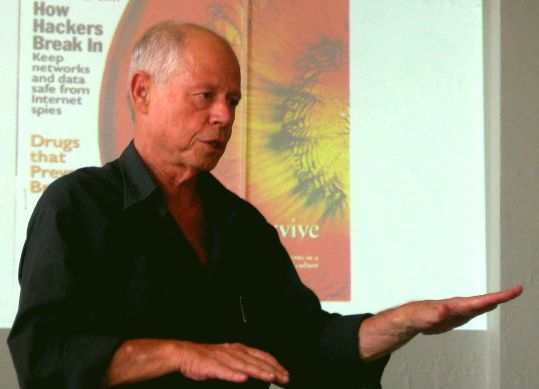Professor Eshel Ben-Jacob
Eshel Ben-Jacob, Ph.D., FAPS is Professor of Physics, Tel Aviv University. He is also holder of the Maguy-Glass Chair in Physics of Complex Systems, and Fellow of the Center for Theoretical Biological Physics (CTBP) at the University of California San Diego.
During the 1980s he became an international leader in the theory of self-organization and pattern formation in open systems, and later extended this work to adaptive complex systems and biocomplexity. His specialization in self-organization of complex systems yielded the breakthrough of solving the long standing (since Kepler) snowflake problem.
In the late 1980s, he turned to study of bacterial self-organization, believing that bacteria hold the key to understanding the larger biological systems. He developed new pattern forming bacteria species, became a pioneer in the study of bacterial intelligence and social behaviors of bacteria, and has been an influential figure in establishing the now rapidly evolving Physics of Life (Biological Physics and Physical Biology) disciplines. He is an adviser to the Microbes Mind Forum.
Eshel was born on April 13, 1952 in Haifa, Israel into a family of pioneers that immigrated to Israel in the 30s. His mother, Miriam Ben-Ya’akov, was born in Israel and his father, Ya’akov Breslav, came to Israel with his family at the age of 5. He grew up in Even Yehuda, a village founded in 1932 by a handful of families including his maternal grandparents.
He began conducting research as a teenager, first at home and for several months towards the end of high school, at the Weizmann Institute of Science in Rehovot. After graduating from high school, he matriculated to study physics and mathematics at Tel Aviv University and was drafted to the Israeli Navy two years later. He completed his B.Sc., M.Sc., and most of his Ph.D. studies during the service (1972–1980) first in the Navy Weather Forecast unit and later in the Navy Intelligence. The Navy granted him a special Personal Citation for demonstrating exceptional creative thinking and intellectual courage, thus enabling successful and life saving operation.
Eshel earned his B.Sc. degree (1975) in physics from Tel Aviv University, a Certificate in System Analysis (1976) from the Technion (Israel Institute of Technology), and his M.Sc. degree (1978) (Magna cum laude) (under the supervision of Y. Imry) and Ph.D. degree in physics (1982) (Summa cum laude) (under the supervision of Y. Imry and D. J. Bergman) from Tel Aviv University. After three years (1981–1984) of postdoctoral research at the Kavli Institute for Theoretical Physics in Santa Barbara, he joined the Physics Department at the University of Michigan (1984–1989). Since 1986, he is a faculty member of the School of Physics and Astronomy at Tel Aviv University (full Professor since 1992 and the holder of the Maguy-Glass Chair in Physics of Complex Systems since 2003).
Eshel served as vice president (1998–2001) and president (2001–2004) of the Israel Physical Society. Since 2005, he is a fellow of the Center for Theoretical Biological Physics, University of California San Diego. He is also Fellow of the American Physical Society.
Building upon understanding he gained from research in neuroscience (the inhibition of inhibition principle), Eshel succeeded to break the code of bacterial decision-making. He and his collaborators discovered that the ingenious scheme is composed of a stochastic switch regulated by a timer with adaptable clock rate (that is adjusted by the cell stress) via a special decision-circuit composed of a cascade of inhibitions. The decision-circuits of the individual bacteria are coupled by exchange of chemical messages between the cells to guarantee collective decision for the group benefit. Learn more about his research interests.
His papers include A tale of two stories: astrocyte regulation of synaptic depression and facilitation, Self-assisted Amoeboid Navigation in Complex Environments, Nonlinear gap junctions enable long-distance propagation of pulsating calcium waves in astrocyte networks, Multimodal encoding in a simplified model of intracellular calcium signaling, Glutamate regulation of calcium and IP3 oscillating and pulsating dynamics in astrocytes, and Network structure determines patterns of network reorganization during adult neurogenesis. His patents include DNA-based electronics, System for and method of positioning cells and determining cellular activity thereof, and Control of body electrical activity by magnetic fields.
Watch his Google TechTalk Learning from Bacteria about Social Networks. Read his Google+ profile, his LinkedIn profile, and his Wikipedia profile. Follow his X feed.
